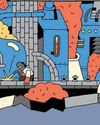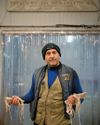
Almost every antiviral vaccine ever sold works in a similar way: A dead or weakened virus, or a piece of one, is introduced into a healthy person. The weakened virus stimulates the immune system to generate antibodies, protecting the person when the real pathogen threatens to infect them.
Over the decades, this tried-and-true approach has vanquished polio, eradicated smallpox, and reined in chickenpox, measles, and mumps. But vaccine production has never been simple or fast. Many flu vaccines are still grown in chicken eggs. Newer approaches draw on genetic engineering to eliminate the need for whole viruses, but their viral proteins are still grown inside live cells.
The coronavirus vaccines from Moderna Inc., in Cambridge, Mass., and its German rival BioNTech SE propose to immunize people in a radically different way: by harnessing human cells to become miniature vaccine factories in their own right. Instead of virus proteins, the vaccines contain genetic instructions that prompt the body to produce them. Those instructions are carried via messenger RNA, or mRNA.
Moderna’s mRNA-1273 consists of a strand of mRNA that tells the body to produce the spike protein the coronavirus uses to latch onto human cells. The strand is like one side of a zipper; the “teeth” are a sequence of chemical letters that cells read to produce the 1,273 amino acids that make up the spike protein. If the vaccine works as intended, the body will start producing the proteins soon after injection, prompting the immune system to react and build up protective antibodies against them.
This story is from the August 17 - 24, 2020 edition of Bloomberg Businessweek.
Start your 7-day Magzter GOLD free trial to access thousands of curated premium stories, and 8,500+ magazines and newspapers.
Already a subscriber ? Sign In
This story is from the August 17 - 24, 2020 edition of Bloomberg Businessweek.
Start your 7-day Magzter GOLD free trial to access thousands of curated premium stories, and 8,500+ magazines and newspapers.
Already a subscriber? Sign In

Instagram's Founders Say It's Time for a New Social App
The rise of AI and the fall of Twitter could create opportunities for upstarts

Running in Circles
A subscription running shoe program aims to fight footwear waste

What I Learned Working at a Hawaiien Mega-Resort
Nine wild secrets from the staff at Turtle Bay, who have to manage everyone from haughty honeymooners to go-go-dancing golfers.

How Noma Will Blossom In Kyoto
The best restaurant in the world just began its second pop-up in Japan. Here's what's cooking

The Last-Mover Problem
A startup called Sennder is trying to bring an extremely tech-resistant industry into the age of apps

Tick Tock, TikTok
The US thinks the Chinese-owned social media app is a major national security risk. TikTok is running out of ways to avoid a ban

Cleaner Clothing Dye, Made From Bacteria
A UK company produces colors with less water than conventional methods and no toxic chemicals

Pumping Heat in Hamburg
The German port city plans to store hot water underground and bring it up to heat homes in the winter

Sustainability: Calamari's Climate Edge
Squid's ability to flourish in warmer waters makes it fitting for a diet for the changing environment

New Money, New Problems
In Naples, an influx of wealthy is displacing out-of-towners lower-income workers